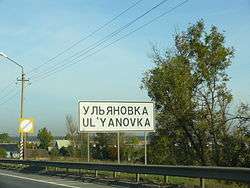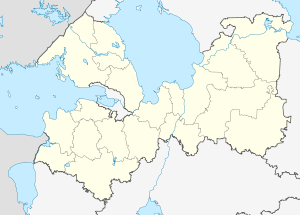Ulyanovka, Leningrad Oblast
| Ulyanovka (English) Ульяновка (Russian) | |
|---|---|
| - Urban-type settlement[1] - | |
 Entrance to the settlement | |
.svg.png) Location of Leningrad Oblast in Russia | |
 Ulyanovka | |
|
| |
| Administrative status | |
| Country | Russia |
| Federal subject | Leningrad Oblast |
| Administrative district | Tosnensky District[1] |
| Municipal status (as of February 2010) | |
| Municipal district | Tosnensky Municipal District[2] |
| Urban settlement | Ulyanovskoye Urban Settlement[2] |
| Administrative center of | Ulyanovskoye Urban Settlement[2] |
| Statistics | |
| Population (2010 Census) | 11,601 inhabitants[3] |
| Time zone | MSK (UTC+03:00)[4] |
| Urban-type settlement status since | 1925[5] |
| Previous names | Sablino (until 1922)[6] |
|
| |
| Ulyanovka on Wikimedia Commons | |
Ulyanovka (Russian: Ульяновка) is an urban locality (an urban-type settlement) in Tosnensky District of Leningrad Oblast, Russia, located approximately 40 kilometres (25 mi) southeast of the center of Saint Petersburg. Municipally it is incorporated as Ulyanovskoye Urban Settlement, one of the seven urban settlements in the district. Population: 11,601 (2010 Census);[3] 9,244 (2002 Census);[7] 9,595 (1989 Census).[8]
History

Until 1922, the name of Ulyanovka was Sablino. In the 1900s, Sablino was a summer house settlement, a part of Tsarskoselsky Uyezd of Saint Petersburg Governorate. In 1918, Sablino split off Tosnenskaya Volost and became the center of Sablinskaya Volost. On November 20, 1918 the uyezd was renamed Detskoselsky.[9] Sablino was renamed Ulyanovka in 1922 after Vladimir Lenin whose original surname was Ulyanov.[6] On August 12, 1922 Detskoselsky Uyezd was merged with Petergofsky Uyezd to form Gatchinsky Uyezd (since 1923, Trotsky Uyezd). On June 16, 1925 Ulyanovka was granted urban-type settlement status. On February 7, 1927, it was transferred to Leningradsky Uyezd. The governorate was renamed Petrogradsky in 1913 and Leningradsky in 1924.[5][10]
On August 1, 1927, the uyezds were abolished and Kolpinsky District, with the administrative center in the town of Kolpino, was established. The governorates were also abolished, and the district was a part of Leningrad Okrug of Leningrad Oblast. Ulyanovka became a part of Kolpinsky District. On July 23, 1930, the okrugs were abolished as well, and the districts were directly subordinated to the oblast. On August 19, 1930 the district was abolished.[11] Ulyanovka became a part of newly established Tosnensky District.[12]
Economy
Industry
In Ulyanovka, there is a plant producing aluminium tubes and a plant producing block timber homes.[13]
Transportation
Ulyanovka (Sablino railway station) is an important railway node, a crossing of the Moscow – Saint Petersburg Railway and the railroad between Mga and Gatchina, encircling Saint Peterburg from the south.
The M10 highway, connecting Saint Petersburg and Moscow, passes west of Ulyanovka, and the A120 road, which encircles Saint Petersburg, passes east and south of the settlement. Ulyanovka is additionally connected by a road with Otradnoye via Nikolskoye.
Culture and recreation
Ulyanovka contains two objects classified as cultural and historical heritage of federal significance and one designated as a historical monument of local significance.[14] The federal monuments are the houses (formerly summer houses) visited by Vladimir Lenin; one of them was owned by his sister, Anna Ulyanova. The local monument is a mass grave of soldiers fallen during World War II.
References
Notes
- 1 2 Государственный комитет Российской Федерации по статистике. Комитет Российской Федерации по стандартизации, метрологии и сертификации. №ОК 019-95 1 января 1997 г. «Общероссийский классификатор объектов административно-территориального деления. Код 41 248 564 007», в ред. изменения №259/2014 от 12 декабря 2014 г.. (State Statistics Committee of the Russian Federation. Committee of the Russian Federation on Standardization, Metrology, and Certification. #OK 019-95 January 1, 1997 Russian Classification of Objects of Administrative Division . Code 41 248 564 007, as amended by the Amendment #259/2014 of December 12, 2014. ).
- 1 2 3 Law #116-oz
- 1 2 Russian Federal State Statistics Service (2011). "Всероссийская перепись населения 2010 года. Том 1" [2010 All-Russian Population Census, vol. 1]. Всероссийская перепись населения 2010 года (2010 All-Russia Population Census) (in Russian). Federal State Statistics Service. Retrieved June 29, 2012.
- ↑ Правительство Российской Федерации. Федеральный закон №107-ФЗ от 3 июня 2011 г. «Об исчислении времени», в ред. Федерального закона №271-ФЗ от 03 июля 2016 г. «О внесении изменений в Федеральный закон "Об исчислении времени"». Вступил в силу по истечении шестидесяти дней после дня официального опубликования (6 августа 2011 г.). Опубликован: "Российская газета", №120, 6 июня 2011 г. (Government of the Russian Federation. Federal Law #107-FZ of June 31, 2011 On Calculating Time, as amended by the Federal Law #271-FZ of July 03, 2016 On Amending Federal Law "On Calculating Time". Effective as of after sixty days following the day of the official publication.).
- 1 2 Петроградский уезд (1917 - янв. 1924), Ленинградский уезд( янв.1924 г.- авг. 1927 г.) (in Russian). Система классификаторов исполнительных органов государственной власти Санкт-Петербурга. Retrieved February 4, 2013.
- 1 2 Гришина,, Л. И.; Файнштейн, Л. А. (1973). Памятные места Ленинградской области (in Russian).
- ↑ Russian Federal State Statistics Service (May 21, 2004). "Численность населения России, субъектов Российской Федерации в составе федеральных округов, районов, городских поселений, сельских населённых пунктов – районных центров и сельских населённых пунктов с населением 3 тысячи и более человек" [Population of Russia, Its Federal Districts, Federal Subjects, Districts, Urban Localities, Rural Localities—Administrative Centers, and Rural Localities with Population of Over 3,000] (XLS). Всероссийская перепись населения 2002 года [All-Russia Population Census of 2002] (in Russian). Retrieved August 9, 2014.
- ↑ Demoscope Weekly (1989). "Всесоюзная перепись населения 1989 г. Численность наличного населения союзных и автономных республик, автономных областей и округов, краёв, областей, районов, городских поселений и сёл-райцентров" [All Union Population Census of 1989: Present Population of Union and Autonomous Republics, Autonomous Oblasts and Okrugs, Krais, Oblasts, Districts, Urban Settlements, and Villages Serving as District Administrative Centers]. Всесоюзная перепись населения 1989 года [All-Union Population Census of 1989] (in Russian). Институт демографии Национального исследовательского университета: Высшая школа экономики [Institute of Demography at the National Research University: Higher School of Economics]. Retrieved August 9, 2014.
- ↑ Царскосельский уезд (1917 - нояб. 1918), Детскосельский уезд (ноябрь1918- фев.1923) (in Russian). Система классификаторов исполнительных органов государственной власти Санкт-Петербурга. Retrieved February 4, 2013.
- ↑ Гатчинский уезд (февр. 1923-авг. 1927) (in Russian). Система классификаторов исполнительных органов государственной власти Санкт-Петербурга. Retrieved February 4, 2013.
- ↑ Колпинский район (август 1927 г . – август 1930 г.) (in Russian). Система классификаторов исполнительных органов государственной власти Санкт-Петербурга. Retrieved February 4, 2013.
- ↑ Тосненский район (август 1930) (in Russian). Система классификаторов исполнительных органов государственной власти Санкт-Петербурга. Retrieved February 4, 2013.
- ↑ Тосненский район (in Russian). 47news.ru. Retrieved 4 February 2013.
- ↑ Памятники истории и культуры народов Российской Федерации (in Russian). Russian Ministry of Culture. Retrieved 2 June 2016.
Sources
- Законодательное собрание Ленинградской области. Областной закон №32-оз от 15 июня 2010 г. «Об административно-территориальном устройстве Ленинградской области и порядке его изменения», в ред. Областного закона №23-оз от 8 мая 2014 г. «Об объединении муниципальных образований "Приморское городское поселение" Выборгского района Ленинградской области и "Глебычевское сельское поселение" Выборгского района Ленинградской области и о внесении изменений в отдельные Областные законы». Вступил в силу со дня официального опубликования. Опубликован: "Вести", №112, 23 июня 2010 г. (Legislative Assembly of Leningrad Oblast. Oblast Law #32-oz of June 15, 2010 On the Administrative-Territorial Structure of Leningrad Oblast and on the Procedures for Its Change, as amended by the Oblast Law #23-oz of May 8, 2014 On Merging the Municipal Formations of "Primorskoye Urban Settlement" in Vyborgsky District of Leningrad Oblast and "Glebychevskoye Rural Settlement" in Vyborgsky District of Leningrad Oblast and on Amending Various Oblast Laws. Effective as of the day of the official publication.).
- Законодательное собрание Ленинградской области. Областной закон №32-оз от 15 июня 2010 г. «Об административно-территориальном устройстве Ленинградской области и порядке его изменения», в ред. Областного закона №23-оз от 8 мая 2014 г. «Об объединении муниципальных образований "Приморское городское поселение" Выборгского района Ленинградской области и "Глебычевское сельское поселение" Выборгского района Ленинградской области и о внесении изменений в отдельные Областные законы». Вступил в силу со дня официального опубликования. Опубликован: "Вести", №112, 23 июня 2010 г. (Legislative Assembly of Leningrad Oblast. Oblast Law #32-oz of June 15, 2010 On the Administrative-Territorial Structure of Leningrad Oblast and on the Procedures for Its Change, as amended by the Oblast Law #23-oz of May 8, 2014 On Merging the Municipal Formations of "Primorskoye Urban Settlement" in Vyborgsky District of Leningrad Oblast and "Glebychevskoye Rural Settlement" in Vyborgsky District of Leningrad Oblast and on Amending Various Oblast Laws. Effective as of the day of the official publication.).
- Законодательное собрание Ленинградской области. Областной закон №116-оз от 22 декабря 2004 г. «Об установлении границ и наделении соответствующим статусом муниципального образования Тосненский муниципальный район и муниципальных образований в его составе», в ред. Областного закона №17-оз от 6 мая 2010 г «О внесении изменений в некоторые областные законы в связи с принятием федерального закона "О внесении изменений в отдельные законодательные акты Российской Федерации в связи с совершенствованием организации местного самоуправления"». Вступил в силу через 10 дней со дня официального опубликования (9 января 2005 г.). Опубликован: "Вестник Правительства Ленинградской области", №44, 30 декабря 2004 г. (Legislative Assembly of Leningrad Oblast. Oblast Law #116-oz of December 22, 2004 On Establishing the Borders of and Granting an Appropriate Status to the Municipal Formation of Tosnensky Municipal District and to the Municipal Formations It Comprises, as amended by the Oblast Law #17-oz of May 6, 2010 On Amending Various Oblast Laws Due to the Adoption of the Federal Law "On Amending Various Legislative Acts of the Russian Federation Due to the Improvement of the Organization of the Local Self-Government". Effective as of after 10 days from the day of the official publication (January 9, 2005).).